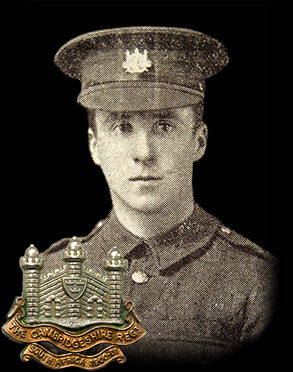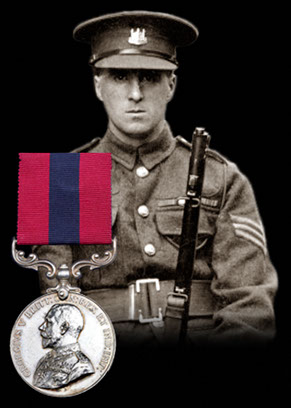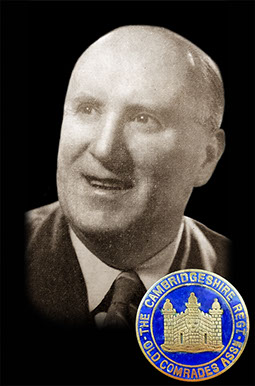Lieutenant Edgar Lewis Anderson DCM
Edgar was born on March 17, 1895 in Cambridge; he lived at 5 Chedworth Street, later moving to 42 Leys Avenue. He attended the Cambridge High School for Boys which we now know as Hill’s Road Sixth Form College.
He enlisted with the Cambridgeshires, service number 2279 on the September 4, 1914, giving his civilian occupation as Clerk. He most likely worked for his father, who owned the local glass making firm W.H. Constable & Co in Eden Street. The business had been founded in 1848 and acquired by Edgar’s father in 1890 and was inherited by Edgar when his father died. He sailed with the 1/1st Cambridgeshires when they were sent to France on February 14, 1915 but shortly after arrival had a spell of seven weeks in hospital suffering from blood poisoning. Some months later, in the early hours of July 3, whilst the battalion was in the front line trenches at Armentieres, he was part of a group of five men hit by the explosion of an enemy rifle grenade and was wounded in the spine. Of the others, Lieutenant Crookham and Private C.F. Howard died of their wounds and Privates Cook and Stepney were sent with Anderson to hospital in Armentieres.
Edgar returns to the UK on the December 21, 1915 and is posted to the 3rd Battalion. He is promoted to Acting Lance Corporal (unpaid) on September 13, 1916 and Lance Corporal (paid) on October 1, 1916. Reverting back to rank of Private he is then posted back to 1/1st Battalion in France on March 15, 1917, arriving in a draft of 26 men on March 21. Shortly after this his service number is changed to 325619 as part of an Army wide renumbering.
When the Cambridgeshires take part in the Third Battle of Ypres, with St Julien and Hill 19 as their specific objectives, on July 31, 1917, Edgar has been attached to the Trench Mortar section. His role is to advance with the attacking troops and set up a trench mortar to give fire support. The advance started at approximately 0500, with the men advancing under fire and taking their objectives almost five hours later. They pushed on capturing Hill 19 and Border House at which point the advance was checked and the Division on the Cambridgeshire’s right flank was driven back. At this point the Cambridgeshire were forced to fall back, towards St Julien, both to preserve the flank and prevent the enemy from working in around and cutting them off, and to consolidate their capture of St Julien. Casualties were mounting, with NCOs taking command from wounded officers and briefly the situation looked dangerous. Edgar was in the thick of it, but keeping his head and almost certainly acting above his rank, organising and fighting as small pockets of men fell back. Some, who bravely held their posts were eventually cut off and captured. Edgar was awarded the Distinguished Conduct Medal for his gallantry that day, the following citation appearing in the London Gazette of January 26, 1918:
For conspicuous gallantry and devotion to duty. Though wounded in the assembly position for an attack, he carried the gun 4,000 yards to the objective, and dug in under very heavy fire. He was rapidly outflanked, and, all his team having been wounded, he remained behind and blew up his gun. He then fell back and joined the infantry, using his rifle to help repel the attack. He acted throughout the operation with great coolness and devotion to duty.
He was promoted to Lance Corporal (paid) on August 1, 1917, the day following the battle, and is still with the battalion at the battle for Tower Hamlets Ridge in late September. A month later on October 17, at an interview in the field, Edgar is recommended for a commission by the Commanding Officer of the Trench Mortar section, Captain Saville. This recommendation is endorsed by Brigadier Bellingham, Commanding Officer, 118 Infantry Brigade, who had overseen the Cambridgeshire’s attack at St Julien, and who had probably also endorsed Edgar’s DCM recommendation. Before he can leave for officer training though Edgar is wounded by a gas attack on October 29 and posted back to the Depot on November 8 and then on to the Reserve Battalion on January 21, just a few days before the official announcement of his DCM in the London Gazette.
Edgar is described in his application for a commission as having a good power of command and leadership, with Bombing and Trench Mortar as special qualifications and concluding that “he will do well in the field in command of a platoon”. His physical description was given as: fit, with good eyesight, 5 feet 6 inches tall and 10 stone 2 lbs in weight with a 36 inch chest. He joined his officer training unit on May 10, 1918.
Edgar doesn’t serve overseas again, with the War finishing in November, before he completes his officer training. His wedding to Gladys Margaret Thurlbourn at St. Barnabas Church on December 14, 1918, is reported in the local papers accompanied by a photograph of the happy couple, Edgar’s white Officer Cadet hat-band clearly visible in the photo. His commission is subsequently formally gazetted on February 11, 1919, with the Cambridgeshire Regiment. It’s worth noting that it was quite unusual for men to be commissioned into the same regiment, the logic presumably being that it was easier to command men who weren’t your friends, and didn’t know you from before your commission. For men wearing the ribbons of gallantry awards, especially the DCM, this logic is questionable; after all, who else might you rely on in battle as a leader more than someone who has already proved their worth under fire?
With the War over and the Army undergoing a huge reduction in size Edgar is disembodied under Army Order 42 of 1919. He relinquished his commission on September 30, 1921 but retained the rank of 2nd Lieutenant. The announcement to this effect appears in the London Gazette of December 8, 1921. It is assumed Edgar returns to the family business and picks up his old life.
After two years however, Edgar decides to re-enlist with the Cambridgshires, who have survived some fairly savage defence cuts, and he is given the service number 5831673. He serves throughout the 1920s and 30s, receiving his Efficiency Medal, and is the escort to the Colour at the Coronation in 1937. It is interesting to note that the platoon which represents the Cambridgeshire Regiment at the Coronation contains no less than ten First World War veterans including six gallantry medal winners. Two years later and Britain is again at War with Germany. Edgar, by now 44 years old volunteers again as a Sergeant Instructor, training regular soldiers, but after suffering a broken ankle is transferred to the Home Guard. He serves with the Home Guard in Cambridge from March 1942 through to December 1944 by which time he’s approaching 50 years of age.
After the War Edgar enters local politics, he is elected as a Conservative Cambridge City Councillor, representing the East Chesterton Ward and serves from 1955-1964. Five years later, at the age of 74 Edgar has a stroke, he dies shortly afterwards, on June 15, 1969 in Addenbrooke’s Hospital, Trumpington Street, Cambridge. He is still the company director of W.H. Constable Glass, and still living at 42 Lees Avenue. His obituary in the Cambridge Evening News, as well as noting his service in both World Wars and his DCM, describes him as a life member of Cambridge City Supporters Club and a Freemason of Lodge 441.

Edgar shortly after joining the Cambs.

Edgar after re-enlisting in the Cambs.

Edgar circa 1960.

This site went live on the 14th February 2015 to mark 100 years since the 1/1st Cambs went off to war.
WE WILL REMEMBER THEM
Email us: cambsregt@gmail.com
Copyright 2015, 2016, 2017, 2018, 2019 by Felix Jackson. The information and images on this site should not be reproduced without prior permission.